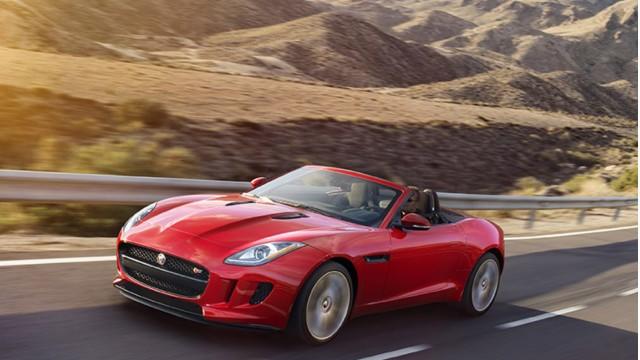YAHOO COM

Jaguar last week at the Los Angeles Auto Show revealed that all-wheel drive is the future of V-8-powered Type R models of its F-Type sports car, while a manual transmission will be offered on the V-6 variants.
Both of those pieces of news are likely to boost the appeal of Jag’s hot-selling sports-car. But there’s one more piece of news for the 2016 F-Type that might not be received quite as well by enthusiasts: Electric power steering is arriving to the lineup.
That’s because while electric power steering brings a long list of advantages, like energy savings and better packaging, it hasn’t always brought a better driving experience—especially when it’s installed in performance cars.
But according to the F-Type’s chief engineer, Russ Varney, if they’ve done their job right you won’t notice all that much of a difference in the 2016 F-Type with electric assist, versus the 2014 and 2015 models with hydraulic assist.
“We’ve had a long relationship with ZF with the hydraulic systems, and they know how we tune our gear, so it was natural
progression,” said Varney, who described the ZF-supplied electric system as one that was ‘bespoke,’ and tuned by Jaguar engineers.
“When we first launched F-Type, we weren’t completely convinced that EPAS technology had advanced well enough to be deployed in the F-Type,” said Varney. “So we launched with the hydraulic system, and it was a system that we knew very well.”
“What it gives us the opportunity to do is to take that last one percent of tuning, to make sure that every application is as good as the best one.”At present there are three different calibrations for the F-Type, Varney explained, although they could have one for every option and tire variant if needed.
Engineers went into the project with very objective criteria of how Jaguar steering should be. “We’ll map out what we want the steering weighting to be in certain conditions at speeds, what the yaw gain should be...and we’ll set ourselves a window of operation for what we need to get into.”
Varney confirmed that the systems in the F-Type and the system in the upcoming XE have different ratios and are different part numbers, but they were developed at the same time.
And he cautioned that electric steering can’t simply be ‘plugged in.’ Suspension geometry, weight distribution, and the stiffness of the body structure all factor into steering feel, too, Varney explained, and that can’t be underestimated.
Both of those pieces of news are likely to boost the appeal of Jag’s hot-selling sports-car. But there’s one more piece of news for the 2016 F-Type that might not be received quite as well by enthusiasts: Electric power steering is arriving to the lineup.
But according to the F-Type’s chief engineer, Russ Varney, if they’ve done their job right you won’t notice all that much of a difference in the 2016 F-Type with electric assist, versus the 2014 and 2015 models with hydraulic assist.
“We’ve had a long relationship with ZF with the hydraulic systems, and they know how we tune our gear, so it was natural
progression,” said Varney, who described the ZF-supplied electric system as one that was ‘bespoke,’ and tuned by Jaguar engineers.
“When we first launched F-Type, we weren’t completely convinced that EPAS technology had advanced well enough to be deployed in the F-Type,” said Varney. “So we launched with the hydraulic system, and it was a system that we knew very well.”
But at this point, several years after that decision, Jaguar has an electric system that doesn’t just match the feel of the hydraulic system, but delivers ‘more’ than the hydraulic one—and what the chief engineer says makes it superior for enthusiasts is that it delivers the sort of consistency across conditions and among different wheel-and-tire combinations that couldn’t be achieved before.
“We’re happy that we’ve got a system that gives all the steering precision and feedback that we want, and now we’ll actually take away unwanted feedback and give us some of the potential for tuning—like in cold ambients (temperatures), we can tune the steering weighting to always feel the same.”“What it gives us the opportunity to do is to take that last one percent of tuning, to make sure that every application is as good as the best one.”At present there are three different calibrations for the F-Type, Varney explained, although they could have one for every option and tire variant if needed.
Engineers went into the project with very objective criteria of how Jaguar steering should be. “We’ll map out what we want the steering weighting to be in certain conditions at speeds, what the yaw gain should be...and we’ll set ourselves a window of operation for what we need to get into.”
Varney confirmed that the systems in the F-Type and the system in the upcoming XE have different ratios and are different part numbers, but they were developed at the same time.
And he cautioned that electric steering can’t simply be ‘plugged in.’ Suspension geometry, weight distribution, and the stiffness of the body structure all factor into steering feel, too, Varney explained, and that can’t be underestimated.
In all, it sounds like the F-Type is in good hands. Whether as a roadster or a coupe, it already brings one of the most enchanting, engaging driving experiences among new models; and we look forward to bringing you an update on how the 2016 Jaguar F-Type drives with these changes, which start arriving next spring.


No comments:
Post a Comment